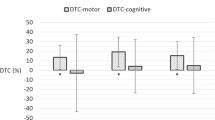Abstract
The objective of the study was to investigate cognitive-motor interference of walking while texting in people with multiple sclerosis (PwMS). The study included 30 PwMS, mean disease duration 11.8 (SD = 6.8) years, and 15 healthy controls. The investigation included a cognitive assessment; texting assessment based on 100 typed characters; and gait assessment under two different conditions: normal walking and walking while texting. Outcome measures included the Symbol Digit Modalities Test to assess cognition. Texting measures included accuracy (%) and duration(s). Gait was assessed with axial accelerometers to quantify temporal measures. The dual-task cost percentage for the walking tests and texting accuracy was determined by calculating the percentage change from a single task to a double task. The impact of texting while walking on gait measures was significantly higher in PwMS; furthermore, texting was less accurate compared to the healthy controls. The dual-task cost for texting accuracy in the PwMS group was 153.3 (SD = 105.7) compared to 8.9 (SD = 26.6) in the healthy group. A significant association was found solely in the PwMS group between cognition and texting accuracy while in a sitting position (R2 = 0.564) and while walking (R2 = 0.534). The dual-task cost of walking and texting appears to be unique in the MS population.
Similar content being viewed by others
References
Benedict RH, DeLuca J, Phillips G et al (2017) Validity of the symbol digit modalities test as a cognition performance outcome measure for multiple sclerosis. Mult Scler 23:721–733
Horak F, King L, Mancini M (2015) Role of body-worn movement monitor technology for balance and gait rehabilitation. Phys Ther 95:461–470
Kalron A, Allali G (2017) Gait and cognitive impairments in multiple sclerosis: the specific contribution of falls and fear of falling. J Neural Transm 124:1407–1416
Kalron A, Dvir Z, Achiron A (2010) Walking while talking - difficulties incurred during the initial stages of multiple sclerosis disease process. Gait Posture 32:332–335
Krasovsky T, Weiss PL, Kizony R (2017) A narrative review of texting as a visually-dependent cognitive-motor secondary task during locomotion. Gait Posture 52:354–362
Kurtzke JF (1983) Rating neurologic impairment in multiple sclerosis: an Expanded Disability Status Scale (EDSS). Neurology 33:1444–1452
Lamberg EM, Muratori LM (2015) Cell phones change the way we walk. Gait Posture 35:688–690
Learmonth YC, Ensari I, Motl RW (2017) Cognitive motor interference in multiple sclerosis: Insights from a systematic quantitative review. Arch Phys Med Rehabil 98:1229
Leone C, Patti F, Feys P (2015) Measuring the cost of cognitive-motor dual tasking during walking in multiple sclerosis. Mult Scler 21:123–131
Lim J, Amado A, Sheehan L, Van Emmerik R (2015) Dual task interference during walking: the effects of texting on situational awareness and gait stability. Gait Posture 42:466–471
Madden M, Rainie L (2010) Adults and cell phone distractions. Pew Research Center, Washington, DC, pp 8–9
Malcay O, Grinberg Y, Berkowitz S, Hershkovitz L, Kalron A (2017) Cognitive-motor interference in multiple sclerosis: what happens when the gait speed is fixed? Gait Posture 57:211–216
Matsuda PN, Verrall AM, Finlayson ML, Molton IR, Jensen MP (2015) Falls among adults aging with disability. Arch Phys Med Rehabil 96:464–471
Nasar J, Hecht P, Wener R (2008) Mobile telephones, distracted attention, and pedestrian safety. Accid Anal Prev 40:69–75
Pau M, Corona F, Pilloni G, Porta M, Coghe G, Cocco E (2018) Texting while walking differently alters gait patterns in people with multiple sclerosis and healthy individuals. Mult Scler Relat Disord 19:129–133
Schabrun SM, van den Hoorn W, Moorcroft A, Greenland C, Hodges PW (2014) Texting and walking: strategies for postural control and implications for safety. PLoS One 9:e84312
Shumway-Cook A, Woollacott M, Kerns KA, Baldwin M (1997) The effects of two types of cognitive tasks on postural stability in older adults with and without a history of falls. J Gerontol A Biol Sci Med Sci 52:M232–M240
Smith A (2011) Americans and text messaging. Pew Research Center, Washington, DC, pp 1–12
Thompson AJ, Banwell B, Barkhof F et al (2018) Diagnostic of multiple sclerosis: 2017 revisions of the McDonald criteria. Lancet Neurol 2018 17(2):162–173
Tian Y, Huang Y, He J, Wei K (2018) What affects gait performance during walking while texting? A comparison of motor, visual and cognitive factors. Ergonomics 16:1–26
Wajda DA, Motl RW, Sosnoff JJ (2013) Dual task cost of walking is related to fall risk in persons with multiple sclerosis. J Neurol Sci 335:160–163
Author information
Authors and Affiliations
Corresponding author
Ethics declarations
Conflict of interest
The authors declare that they have no conflict of interest.
Informed consent
Informed consent was obtained from all individual participants included in the study.
Ethical approval
All procedures performed in studies involving human participants were in accordance with the ethical standards of the institutional and/or national research committee and with the 1964 Helsinki declaration and its later amendments or comparable ethical standards.
Rights and permissions
About this article
Cite this article
Sirhan, B., Frid, L. & Kalron, A. Is the dual-task cost of walking and texting unique in people with multiple sclerosis?. J Neural Transm 125, 1829–1835 (2018). https://doi.org/10.1007/s00702-018-1939-4
Received:
Accepted:
Published:
Issue Date:
DOI: https://doi.org/10.1007/s00702-018-1939-4




